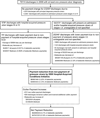Under Pressure: Financial Effect of the Hospital-Acquired Conditions Initiative-A Statewide Analysis of Pressure Ulcer Development and Payment
- PMID: 26140454
- PMCID: PMC5278926
- DOI: 10.1111/jgs.13475
Under Pressure: Financial Effect of the Hospital-Acquired Conditions Initiative-A Statewide Analysis of Pressure Ulcer Development and Payment
Abstract
Objectives: To assess the financial effect of the 2008 Hospital-Acquired Conditions Initiative (HACI) pressure ulcer payment changes on Medicare, other payers, and hospitals.
Design: Retrospective before-and-after study of all-payer statewide administrative data for more than 2.4 million annual adult discharges in 2007 and 2009 using the Healthcare Cost and Utilization Project State Inpatient Datasets for California. How often and by how much the 2008 payment changes for pressure ulcers affected hospital payment was assessed.
Setting: Nonfederal acute care California hospitals (N = 311).
Participants: Adults discharged from acute-care hospitals.
Measurements: Pressure ulcer rates and hospital payment changes.
Results: Hospital-acquired pressure ulcer rates were low in 2007 (0.28%) and 2009 (0.27%); present-on-admission pressure ulcer rates increased from 2.3% in 2007 to 3.0% in 2009. According to clinical stage of pressure ulcer (available in 2009), hospital-acquired Stage III and IV ulcers occurred in 603 discharges (0.02%); 60,244 discharges (2.42%) contained other pressure ulcer diagnoses. Payment removal for Stage III and IV hospital-acquired ulcers reduced payment in 75 (0.003%) discharges, for a statewide payment decrease of $310,444 (0.001%) for all payers and $199,238 (0.001%) for Medicare. For all other pressure ulcers, the Hospital-Acquired Conditions Initiative reduced hospital payment in 20,246 (0.81%) cases (including 18,953 cases with present-on-admission ulcers), reducing statewide payment by $62,538,586 (0.21%) for all payers and $47,237,984 (0.32%) for Medicare.
Conclusion: The total financial effect of the 2008 payment changes for pressure ulcers was negligible. Most payment decreases occurred by removal of comorbidity payments for present-on-admission pressure ulcers other than Stages III and IV. The removal of payment for hospital-acquired Stage III and IV ulcers by implementation of the HACI policy was 1/200th that of the removal of payment for other types of pressure ulcers that occurred in implementation of the Hospital-Acquired Conditions Initiative.
Keywords: Medicare; hospital-acquired conditions; payment; pressure ulcer.
© 2015, Copyright the Authors Journal compilation © 2015, The American Geriatrics Society.
Conflict of interest statement
All authors have completed and submitted the ICJME Form for Disclosure of Potential Conflicts of Interest. The remaining authors report no conflicts of interest.
Figures


References
-
- National Pressure Ulcer Advisory Panel. NPUAP Pressure Ulcer Stages/Categories. [Accessed October 21, 2014]; http://www.npuap.org/resources/educational-and-clinical-resources/npuap-...
-
- Beckrich K, Aronovitch SA. Hospital-acquired pressure ulcers: a comparison of costs in medical vs. surgical patients. Nurs Econ. 1999;17(5):263–271. - PubMed
-
- Rockville, MD: Agency for Healthcare Research and Quality; [Accessed March 5, 2014]. Preventing Pressure Ulcers in Hospitals: A Toolkit for Improving Quality of Care. April 2011. AHRQ Publication No. 11-0053-EF http://www.ahrq.gov/research/ltc/pressureulcertoolkit/putoolkit.pdf.
-
- Pieper B, Langemo D, Cuddigan J. Pressure ulcer pain: a systematic literature review and National Pressure Ulcer Advisory Panel white paper. Ostomy Wound Manage. 2009;55(2):16–31. - PubMed
-
- Lyder CH, Preson J, Grady JN, et al. Quality of care for hospitalized Medicare patients at risk for pressure ulcers. Arch Intern Med. 2001;161:1549–1554. - PubMed
Publication types
MeSH terms
Grants and funding
LinkOut - more resources
Full Text Sources
Other Literature Sources
Medical

